- Created by admin, last modified by AdrianC on May 10, 2017
You are viewing an old version of this page. View the current version.
Compare with Current View Page History
« Previous Version 27 Next »
https://help.myob.com/wiki/x/pjyEAQ
How satisfied are you with our online help?*
Just these help pages, not phone support or the product itself
Why did you give this rating?
Anything else you want to tell us about the help?
New Zealand only (learn about Australian leave on the Fair Work website)
The amount an employee is paid for leave is based on the amount they would usually receive on the day when they took leave. For example, an employee would receive a different hourly rate for leave on a day when they are usually paid more (for example, on a Sunday). Similarly, an employee would receive a different daily rate for leave depending on the number of hours they usually worked.
Note that leave rates include all pay that an employee would usually receive. This includes regular overtime and any commissions that would have been received if they had worked. For more information on holidays and leave, see the Department of Labor’s Holidays and leave guide.
There are several different calculations that can be used to calculate the rate an employee should be paid for leave. In all cases except for annual leave, you can choose which rate most accurately reflects the employee’s usual pay on this day. For annual leave, the highest rate is automatically selected.
You can see details of how each type of leave is calculated by clicking Add holidays or leave when paying your employees, then clicking the leave type.
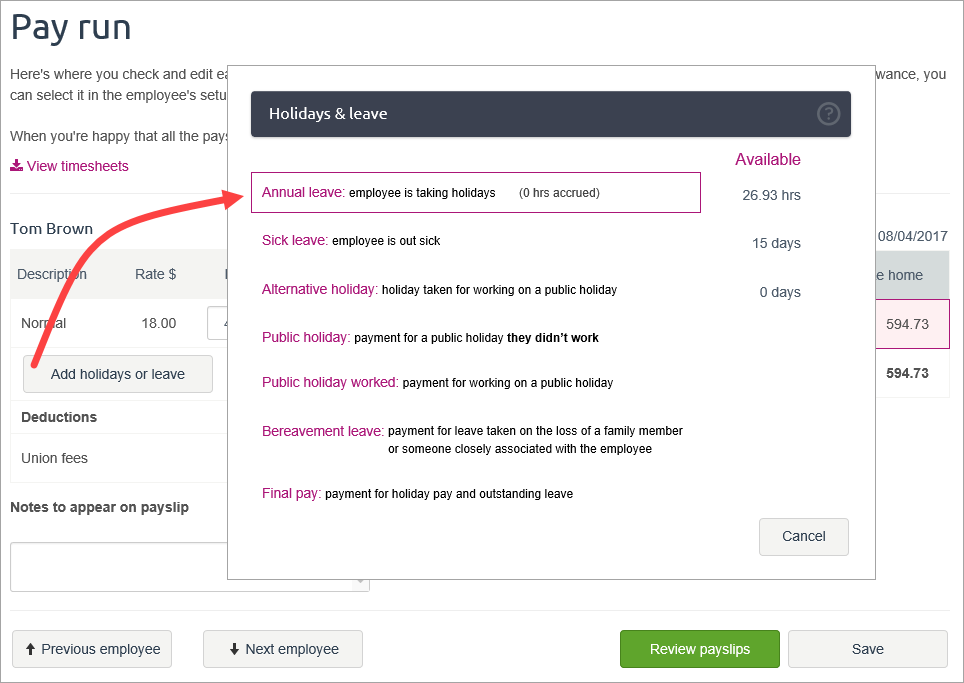
We've described the leave calculations below. You can edit some of the amounts in these leave calculations if required to get a more accurate value of what the employee usually earns on this day.
Need more help? Check out our free Payroll webcast and let an MYOB expert explain what you need to do.
Annual leave rate calculation
Annual leave rates are based on weekly pay, which can be calculated in different ways. Weekly pay is the greater of Average weekly earnings or Ordinary weekly pay.
Note that the calculation giving the highest pay rate will be used for the employee’s annual leave pay. If this is not an accurate reflection, you can change some of the values used in the calculation to more accurately reflect what the employee should be paid.
| |
| A | Annual leave paid in advance is annual leave paid as a lump sum before the employee starts the leave. This will be taxed as "Extra Pay". |
| B | Ordinary weekly pay is the amount the employee is usually paid each week, based on your normal rate of hours. |
| C | If there's a lot of variation in the number of hours the employee works or the allowances they are paid each week, you can select this option which uses the average of the last 4 weeks. |
| D | Average weekly earnings is an average rate based on the last 52 week's earnings. |
Sick leave rate calculation
Sick leave is calculated and paid on a per-day basis. Choose the calculation that best reflects the amount of pay your employee would normally receive on the day they took sick leave.
| |
| A | You need to enter the number of hours and number of days this leave represents. This is used in some of the other calculations on this screen to determine the total amount your employee is to be paid for their sick leave. |
| B | Relevant daily pay is the amount they would normally have received on the day. This will work in most cases. Situations where it won't work include if their hours vary widely. |
| C | Average daily pay is your best option when Relevant daily pay isn't accurate. It is an average rate calculated on the gross earnings for the last 12 months. |
Alternative holiday rate calculation
An alternative holiday is a holiday that an employee is entitled to take in exchange for working on a public holiday.
Pay for alternative holidays should reflect the amount your employee would normally receive for this day, if they had worked. You can choose the calculation that gives the most accurate pay.
| |
| A | You need to enter the number of hours and number of days this leave represents. This is used in some of the other calculations on this screen to determine the total amount your employee is to be paid for their leave. |
| B | Relevant daily pay is the amount they would normally have received on the day. This will work in most cases. Situations where it won't work include if their hours vary widely. |
| C | Average daily pay is your best option when Relevant daily pay isn't accurate. It is an average rate calculated on the gross earnings for the last 12 months. |
Public holiday rate calculation
This screen lets you calculate how much pay your employee should receive for a public holiday that they didn't work. The pay for a public holiday not worked (or ‘taken’) should reflect the amount your employee would normally receive for this day, if they had worked at their normal, non-public holiday rate. You can choose the calculation that gives the most accurate pay.
| |
| A | You need to enter the number of hours and number of days this leave represents. This is used in some of the other calculations on this screen to determine the total amount your employee is to be paid for their leave. |
| B | Relevant daily pay is the amount they would normally have received on the day. This will work in most cases. Situations where it won't work include if their hours vary widely. |
| C | Average daily pay is your best option when Relevant daily pay isn't accurate. It is an average rate calculated on the gross earnings for the last 12 months. |
Public holiday worked rate calculation
Use these calculations to figure out how much your employee would ordinarily have earned on this day, and then multiply it by 1.5 to calculate the public holiday pay. If you pay employees more than 1.5 times their normal wages for public holiday work, you can enter a set daily amount to account for this.
| |
| A | You need to enter the number of hours and number of days this leave represents. This is used in some of the other calculations on this screen to determine the total amount your employee is to be paid for their leave. |
| B | Relevant daily pay is the amount they would normally have received on the day. This will work in most cases. Situations where it won't work include if their hours vary widely. |
| C | Average daily pay is your best option when Relevant daily pay isn't accurate. It is an average rate calculated on the gross earnings for the last 12 months. |
| D | Public holiday multiplier multiplies the public holiday rate by 1.5 to pay time and a half. |
Bereavement leave rate calculation
The goal here is to pick the calculation that's closest to the amount they would normally get on the day they took bereavement leave.
| |
| A | You need to enter the number of hours and number of days this leave represents. This is used in some of the other calculations on this screen to determine the total amount your employee is to be paid for their leave. |
| B | Relevant daily pay is the amount they would normally have received on the day. This will work in most cases. Situations where it won't work include if their hours vary widely. |
| C | Average daily pay is your best option when Relevant daily pay isn't accurate. It is an average rate calculated on the gross earnings for the last 12 months. |
Final pay rate calculation
Use these calculations to figure out how much to pay your employee for their final pay when they stop working for you.
Final pay includes the employee’s full available annual leave and alternative holiday entitlements, plus the holiday pay percentage of gross earnings since their last annual leave anniversary (usually 8%).
Employees should also be paid for public holidays that fall on days they normally would have worked between their last day of work and the end of the period of annual leave being paid out.
Once you’ve paid the final pay, the employee will be inactivated.
| |
| A | The amount of annual leave due is the employee’s available annual leave entitlement, paid at their usual annual leave rate. You can view and edit the calculations that determine this rate by clicking on the rate. For more information about this rate, see Annual leave rate calculation above. |
| B | An employee’s final pay needs to include payment for any public holidays that fall on days they normally would have worked, between their last day of work and the end of the period of annual leave being paid out. If required, enter the number of public holiday hours that should be included in the employee’s final pay. You can view and edit the public holiday rate calculation by clicking on the rate. For more information about this rate, see Public holiday rate calculation above. |
| C | Final pay should include payment for the employee’s alternative holiday entitlement. Enter the number of hours that the employee would normally work to make up the number of alternative holidays due. You can view and edit the rate at which these alternative holidays are paid by clicking on the rate. For more information about this rate, see Alternative holiday rate calculation above. |
| D | The Value of holiday pay since anniversary calculation determines the value of the employee’s accrued holiday pay. This is calculated as their gross earnings since their last anniversary date (including the current pay run), multiplied by the holiday pay percentage. |


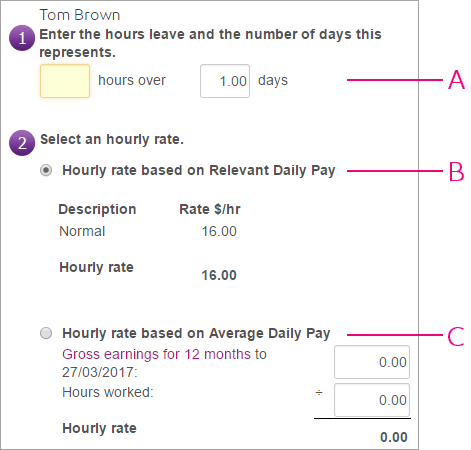
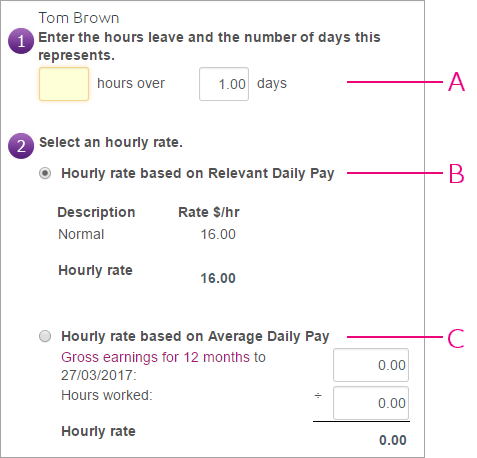
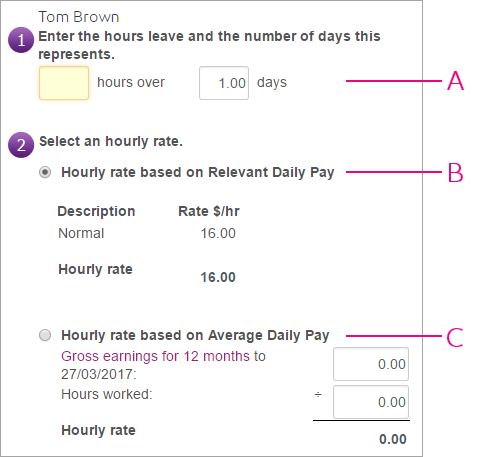
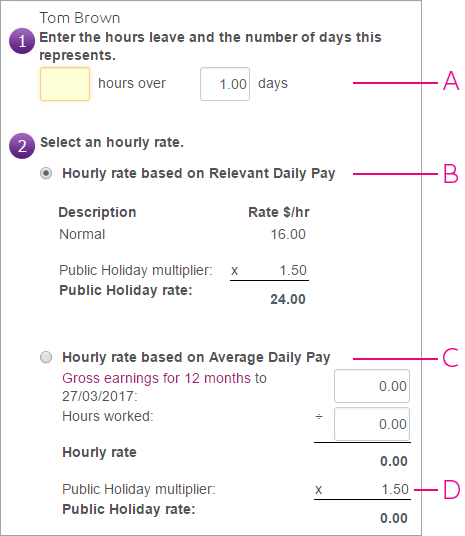
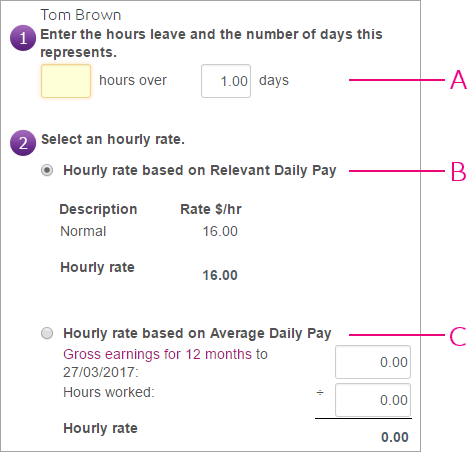
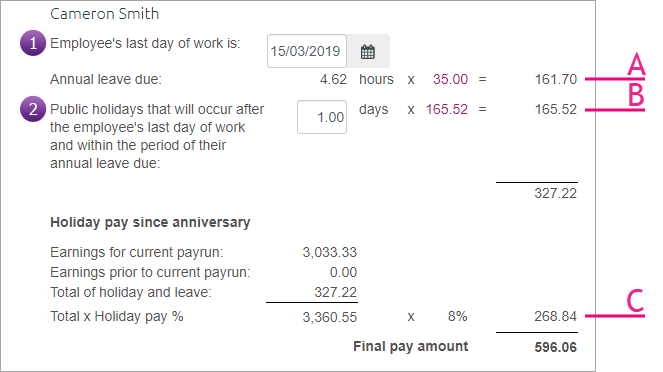
 Yes
Yes
 No
No
 Thanks for your feedback.
Thanks for your feedback.